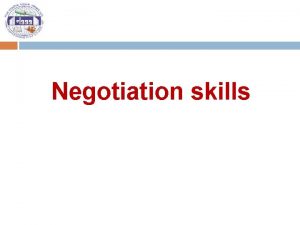CrossCultural Negotiation and Decision Making DOING THE DEAL

































- Slides: 33

Cross-Cultural Negotiation and Decision Making DOING THE DEAL 5 -1

Opening Profile: BP’s Troubled Joint Venture (JV) in Russia In August 2003, the British Petroleum (BP) formed a $6. 7 billion JV called TNK-BP. At the time of signing, the JV was hailed as a major project because it brought tangible FDI to Russia. However, between 2007 and 2009, BP was asked to negotiate and surrender its control and ownership of oil and gas fields in Russia. In 2006 and 2007 BP started to witness state interference in the TNK-BP project and TNK-BP ended up losing its control to a state-controlled gas company. 5 -2

Opening Profile: BP’s Troubled Joint Venture (JV) in Russia In early 2008, state interventions, investigations, and other allegations surfaced regarding labor and employment-related inquiries that pressured BP to hire more Russian staff. As of April 2009, TNK-BP continued to struggle with its board’s appointments and selection of a CEO. The relationship-building and cooperation between BP and Russian partners is far from healthy. 5 -3

Negotiation The process of discussion by which two or more parties aim for mutually acceptable agreement 5 -4

Stakeholders in Cross-Cultural Negotiation 5 -5

The Negotiation Process 5 -6

Stage One: Preparation • Develop profile of counterparts. • Find out likely demands, team composition, and counterpart authority. • Uzbekistan had to learn from scratch • Choose a negotiation site. • British/French Chunnel negotiations 5 -7

Stage Two: Relationship Building • Getting to know one’s contacts • and building mutual trust Use an intermediary. • “I have come as a mediator…” 5 -8

Stage Three: Exchanging Task-Related Information • Cultural differences remain an issue. • The French enjoy debate and conflict. • Mexicans can be suspicious and indirect. • The Chinese ask many questions, but provide ambiguous information in return. ? ? ? • Show understanding of the other viewpoint. 5 -9

Stage Four: Persuasion • Dirty tricks are in the eye of the beholder • False information • Ambiguous authority • Uncomfortable rooms • Rudeness, threats • Calculated delays 5 -10

Stage Five: Concessions and Agreement • Russians and the Chinese start with extreme positions ? ? ? • Swedes start with what they will accept • Starting with extremes may be most effective 5 -11

Management Focus Joint Venture Companies in China

Management Focus: Joint Ventures A Few Lessons We Can Learn Cross-cultural misunderstandings and 5 -13 unfamiliarity with the JV partners may be at the heart of the dispute. Both companies may use media and PR companies instead of having open negotiations. Relationship building and exchange of information is critical in any JV. There may be a lack of open communication in day-to-day management of the JV. In JVs, relationship building takes time and a good amount of interaction between the partners.

Comparison of Negotiation Styles Japanese North American Hide emotions Deal impersonally Subtle power Litigation, not plays conciliation 5 -14 Latin American Emotionally passionate Great power plays Step-by-step approach Methodological Impulsive, organization spontaneous Group good is the aim Profit is the aim Group/individual good is aim

Successful Negotiators: Americans q Knows when to compromise, but stands firm at the q q 5 -15 beginning. Accept compromises only when there is a deadlock. Refuses to make concessions beforehand keeps his/hers cards close to chest. Keeps a maximum of options open before negotiation, operate in good faith. States his/her position as clearly as possible, respects the “opponents”. Is fully briefed about the negotiated issues, has a good sense of timing and is consistent.

Successful Negotiators: Indians q Look for and say the truth, not afraid to speak up. ? ? ? q Exercise self-control. ? ? ? q Respect other party, look for solutions acceptable to all parties. ? ? ? q Will change their minds, even at risk of seeming inconsistent and unpredictable. ? ? ? 5 -16

Successful Negotiators: Arabs q Protect honor, self-respect, dignity, and, thus, are trusted and respected. q Avoid direct confrontation. q Come up with creative, honorable solutions. q Are impartial and can resist pressure. 5 -17

Successful Negotiators: Swedes q Quiet, thoughtful, polite, straightforward q Overcautious, but flexible q Slow to react to new proposals, but eager to be productive and efficient q Able to hide emotions, afraid of confrontation 5 -18

Successful Negotiators: Italians q Have a sense of drama, do not hide emotions q Good at reading facial expressions and gestures q Want to make a good impression and use flattery, but are distrusting q Handle confrontation with subtlety and tact 5 -19

Managing Negotiation Avoid person-related conflicts. Examples Low-context Americans appear impatient, cold, and blunt to Mexicans. 5 -20 Americans must approach negotiations with Mexicans with patience; refrain from attacking ideas.

Cross-Cultural Negotiation Variables EXHIBIT 5 -5 5 -21 Cross-cultural Negotiation Variables Copyright © 2011 Pearson Education, Inc. publishing as Prentice Hall

Using the Internet to Support Negotiations Negotiation Support System (NSS) Increase likelihood of agreement Decrease direct and indirect costs Maximize optimal outcomes 5 -22 Copyright © 2011 Pearson Education, Inc. publishing as Prentice Hall Web Application Provide support for phases and dimensions such as: Multiple-issue, multiple- party business transactions of a buy-sell nature International dispute resolution Internal company negotiations and communications

E-Negotiations Advantages Speed Less travel Laying out much objective information over time 5 -23 Copyright © 2011 Pearson Education, Inc. publishing as Prentice Hall Disadvantages Not being able to build trust and interpersonal relationships Nonverbal nuances are lost Video conferencing may be a good compromise

Comparative Management in Focus: Negotiating with Chinese EXHIBIT 5 -6 5 -24 Influence on Western-Chinese Business Negotiations

Comparative Management in Focus: Negotiating with Chinese ? ? ? Two problems: Chinese desire for harmony details Who has the power to close the deal? Guanxi Saving face: Lien Mien-tzu 5 -25 Importance of Copyright © 2011 Pearson Education, Inc. publishing as Prentice Hall Guanxihu networks Two stages of Chinese negotiation Technical Commercial

Comparative Management in Focus: Negotiating with Chinese Some recommendations: Practice patience. Accept prolonged stalemate. Refrain from exaggerated expectations. Know who can close the deal Resist blaming for difficulties. Understand Chinese cultural traits. WHAT DO YOU RECOMMEND? ? ? 5 -26 Copyright © 2011 Pearson Education, Inc. publishing as Prentice Hall

Managing the Conflict Resolution Instrumental. Oriented Conflict Expressive. Oriented Conflict 5 -27 • To negotiate on the basis of factual information and logical analysis • To handle a situation indirectly and implicitly, without clear delineation of the situation by the person handling it

Low-Context, High-Context Sources of Conflict Low-Context Why Analytic, linear logic Synthetic, spiral logic When Individualisticoriented violations Group-oriented violations What Revealment, confrontational Concealment, nonconfrontational Explicit, open, direct Implicit, ambiguous, indirect How 5 -28 High-Context

The Influence of Culture on Decision Making Individualism VS Collectivism Objective Subjective Risk Tolerance Avoidance Uncertainty 5 -29 Copyright © 2011 Pearson Education, Inc. publishing as Prentice Hall VS VS VS Risk Familiarity

Approaches to Decision Making 5 -30 Utilitarianism Idealism VS Autocratic Participative VS Slow Pace VS Copyright © 2011 Pearson Education, Inc. publishing as Prentice Hall Moral Fast

Cultural Variables in Decision-Making Process EXHIBIT 5 -8 5 -31 Cultural Variables in the Decision-Making Process Copyright © 2011 Pearson Education, Inc. publishing as Prentice Hall

Comparative Management in Focus: Decision Making in Japanese Companies Wa Ringi Amae Shiny o 5 -32 Copyright © 2011 Pearson Education, Inc. publishing as Prentice Hall

Comparative Management in Focus: Decision Making in Japanese Companies EXHIBIT 5 -9 5 -33 Decision Making Procedure in Japanese Companies Copyright © 2011 Pearson Education, Inc. publishing as Prentice Hall
 Cross cultural negotiation and decision making
Cross cultural negotiation and decision making No decision snap decision responsible decision
No decision snap decision responsible decision Financial management process
Financial management process Deal or no deal machine
Deal or no deal machine Asset deal vs share deal
Asset deal vs share deal Anything worth doing is not necessarily worth doing well
Anything worth doing is not necessarily worth doing well Doing nothing is doing ill
Doing nothing is doing ill Decision table and decision tree examples
Decision table and decision tree examples Using recursion in models and decision making
Using recursion in models and decision making Using recursion in models and decision making sheet 3
Using recursion in models and decision making sheet 3 Chapter 6 prices and decision making assessment answers
Chapter 6 prices and decision making assessment answers Model hoy
Model hoy Decision making and relevant information
Decision making and relevant information Best books on problem solving and decision making
Best books on problem solving and decision making Individual and group decision making
Individual and group decision making Importance of decision making
Importance of decision making Perception and individual decision making
Perception and individual decision making 5 step decision making process
5 step decision making process A is a choice made from among available alternatives
A is a choice made from among available alternatives Chapter 2 economic systems and decision making answer key
Chapter 2 economic systems and decision making answer key Decision making and branching example
Decision making and branching example Basic elements of planning and decision making
Basic elements of planning and decision making Individual and group decision making
Individual and group decision making Management chapter 5 planning and decision making
Management chapter 5 planning and decision making Perception and decision making in organizational behavior
Perception and decision making in organizational behavior Decision making and goal setting
Decision making and goal setting Chapter 2 economic systems and decision making
Chapter 2 economic systems and decision making Individual and group decision making
Individual and group decision making Activity resource usage model and tactical decision making
Activity resource usage model and tactical decision making Activity resource usage model and tactical decision making
Activity resource usage model and tactical decision making Decision making and time management
Decision making and time management Decision making and looping in c
Decision making and looping in c Decision making and relevant information
Decision making and relevant information Prominent advantages and disadvantages of consensus
Prominent advantages and disadvantages of consensus























































